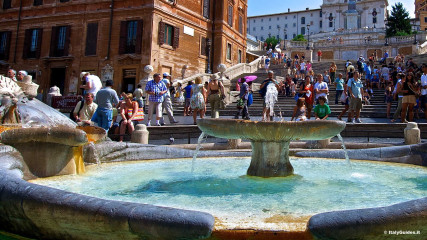With its characteristic butterfly plan, the Spanish Steps or Piazza di Spagna, in Rome, is one of the most famous images in the world, as well as being one of the most majestic urban monuments of Roman Baroque style. In the Renaissance period, the square was the most popular tourist attraction in the city: it attracted artists and writers alike and was full of elegant hotels, inns and residences.
At the end of the seventeenth century, it was called Trinità dei Monti, after the church that dominates the square from above, but it was later given the name we know today after the Spanish Ambassador who lived there.
At the foot of the stairs, you will find the famous Barcaccia Fountain, the work of Pietro Bernini and his son, Gian Lorenzo. The latter went on to become the creator of some of the most important masterpieces of Baroque art in the city, including the renowned baldachino of St. Peter's Basilica.
With its characteristic form of a sinking ship, the fountain recalls the historic flood of the River Tiber in 1598 and refers to a folk legend whereby a fishing boat carried away by the flood of the river was found at this exact spot.
In reality, the sinking boat was ably invented by Bernini to overcome a technical problem due to low water pressure. The sun and bee ornamentation is a symbol of the Barberini family and a reference to Pope Urban VIII who commissioned the work. However, the main attraction of the square has to be the spectacular staircase of Trinità dei Monti.
Built on the request of Innocent XII and created by Francesco De Sanctis in the eighteenth century, this daring architectural feat with its ramps and stairs that intersect and open out like a fan definitively provided a solution for connecting the square and the Trinità Church above, providing the city with a particularly intriguing attraction that is adored by tourists from all over the world.
The sight of the square in spring should not be missed, when the ramps of the staircase are literally covered with flowers and the architecture is playfully lost beneath a magnificent array of colour.















